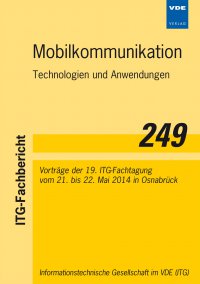The Suitability of Energy-Autonomous Point-to-Point Radio Networks for Wireless Backhauling
Konferenz: Mobilkommunikation – Technologien und Anwendungen - Vorträge der 19. ITG-Fachtagung
21.05.2014 - 22.05.2014 in Osnabrück, Deutschland
Tagungsband: Mobilkommunikation – Technologien und Anwendungen
Seiten: 6Sprache: EnglischTyp: PDF
Persönliche VDE-Mitglieder erhalten auf diesen Artikel 10% Rabatt
Autoren:
Mannweiler, Christian (Intelligent Networks, German Research Center for Artificial Intelligence (DFKI), 67663 Kaiserslautern, Germany)
Schotten, Hans (Wireless Communications and Navigation Research Group, University of Kaiserslautern, 67663 Kaiserslautern, Germany)
Inhalt:
Coordinated point-to-point radio networks constitute a reliable and cost-efficient technology for wireless backhauling, i.e., connecting access networks with backbone infrastructures. In mountainous regions like the Alps, such networks are deployed to provide Internet connectivity to remote villages. Similarly, topologically challenging regions, e.g., of the Canary Islands, are provided with voice and data services by means of such point-to-point radio network deployments. Finally, in Sub- Saharan countries such as Tanzania, they serve as an increasingly popular solution to connect sparsely populated areas to the existing ICT infrastructure. However, due to the usually, remote or hardly accessible location of radio nodes, no power grid for reliable energy supply is available. Rather, backhaul nodes are equipped with photovoltaic modules or wind turbines that charge batteries that in turn supply energy to the network equipment. Since these renewable forms of energy generate a neither constant nor predictable supply of power, these kinds of networks are prone to outages and failures if not designed and operated properly. Consequently, besides a carrier-grade network management, reliable energy budget policies become a significant challenge in the operation of these energy-autonomous wireless backhaul networks. Another solution, among several more, is to deploy excess battery capacity that can handle periods of lull or overcast (dark) skies. Accounting for the solar irradiation patterns of typical deployment areas of these networks, this work investigates if solar-power driven point-to-point radio networks are a feasible, reliable backhauling solution.


